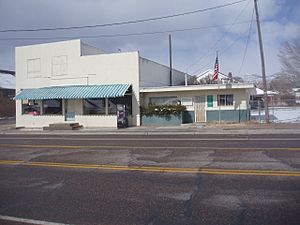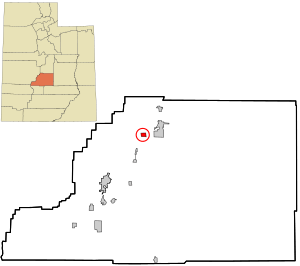Aurora, Utah facts for kids
Quick facts for kids
Aurora, Utah
|
|
|---|---|

Aurora city office building on North Main Street (SR-260), April 2010
|
|

Location in Sevier County and the state of Utah.
|
|
| Country | United States |
| State | Utah |
| County | Sevier |
| Settled | 1875 |
| Incorporated | 1914 |
| Became a city | January 1982 |
| Area | |
| • Total | 0.92 sq mi (2.39 km2) |
| • Land | 0.92 sq mi (2.39 km2) |
| • Water | 0.00 sq mi (0.00 km2) |
| Elevation | 5,200 ft (1,585 m) |
| Population
(2010)
|
|
| • Total | 1,016 |
| • Estimate
(2019)
|
1,052 |
| • Density | 1,138.53/sq mi (439.44/km2) |
| Time zone | UTC-7 (MST) |
| • Summer (DST) | UTC-6 (MDT) |
| ZIP code |
84620
|
| Area code(s) | 435 |
| FIPS code | 49-02740 |
| GNIS feature ID | 1438307 |
Aurora is a small city located in the middle part of Sevier County, Utah, United States. In 2020, about 923 people lived there.
The city's economy mainly relies on farming, coal mining, and service jobs. Most people who live in Aurora travel to nearby towns for work. Kids in Aurora go to school in Salina, which is a neighboring community. The city is growing because more businesses are coming to the area.
Contents
Geography and Climate
Aurora covers about 1 square mile (2.39 square kilometers) of land. There is no water within the city limits.
What is Aurora's Climate Like?
Aurora has a climate with big changes in temperature throughout the year. Summers are warm to hot, and sometimes humid. Winters are cold, and can be very cold. This type of weather is called a humid continental climate.
History of Aurora
How Aurora Was Founded
Aurora was started in 1875 by Ezra White and three other families. They settled along the Sevier River. The area had many willow trees, so they first named their settlement Willowbend.
Why the Name Changed to Aurora
The name was later changed to Aurora. This happened because people saw the beautiful Northern Lights there. The colors reminded the local Postmaster of the Roman Goddess of dawn, whose name is Aurora.
Moving the City and Growing the Community
The city was moved a few miles west to avoid spring floods from the Sevier River. This new spot also made it easier to farm the land. The first settlers found the area quite empty, with no green trees. But over time, they planted crops and trees, and used irrigation to make Aurora a lovely place to live.
Aurora is in the fertile Sevier Valley. It grew slowly as more settlers arrived. While nearby towns like Salina and Richfield grew faster, Aurora mainly grew as children from the original families stayed and built their lives there. Many people living in Aurora today can trace their family back to one of the four founding families.
Population and People
| Historical population | |||
|---|---|---|---|
| Census | Pop. | %± | |
| 1880 | 146 | — | |
| 1890 | 306 | 109.6% | |
| 1900 | 385 | 25.8% | |
| 1910 | 409 | 6.2% | |
| 1920 | 615 | 50.4% | |
| 1930 | 568 | −7.6% | |
| 1940 | 607 | 6.9% | |
| 1950 | 614 | 1.2% | |
| 1960 | 465 | −24.3% | |
| 1970 | 493 | 6.0% | |
| 1980 | 874 | 77.3% | |
| 1990 | 911 | 4.2% | |
| 2000 | 947 | 4.0% | |
| 2010 | 1,016 | 7.3% | |
| 2019 (est.) | 1,052 | 3.5% | |
| U.S. Decennial Census | |||
Who Lives in Aurora?
In 2000, there were 947 people living in Aurora. Most people were White (about 97.68%). A small number of people were Native American, Asian, or Pacific Islander. About 1.37% of the population was Hispanic or Latino.
Families and Age Groups
There were 303 households in Aurora in 2000. About 43.6% of these households had children under 18 living with them. Most households (83.8%) were married couples living together.
The average household had about 3.13 people. The average family had about 3.38 people.
The population was spread out by age:
- 33.2% were under 18 years old.
- 9.3% were between 18 and 24.
- 25.0% were between 25 and 44.
- 20.3% were between 45 and 64.
- 12.2% were 65 years or older.
The average age in Aurora was 32 years old.
Income in Aurora
In 2000, the average income for a household in Aurora was about $44,911 per year. For families, the average income was about $50,000 per year.
Notable Person
- David E. Sorensen, a leader in The Church of Jesus Christ of Latter-day Saints.
See also
 In Spanish: Aurora (Utah) para niños
In Spanish: Aurora (Utah) para niños




